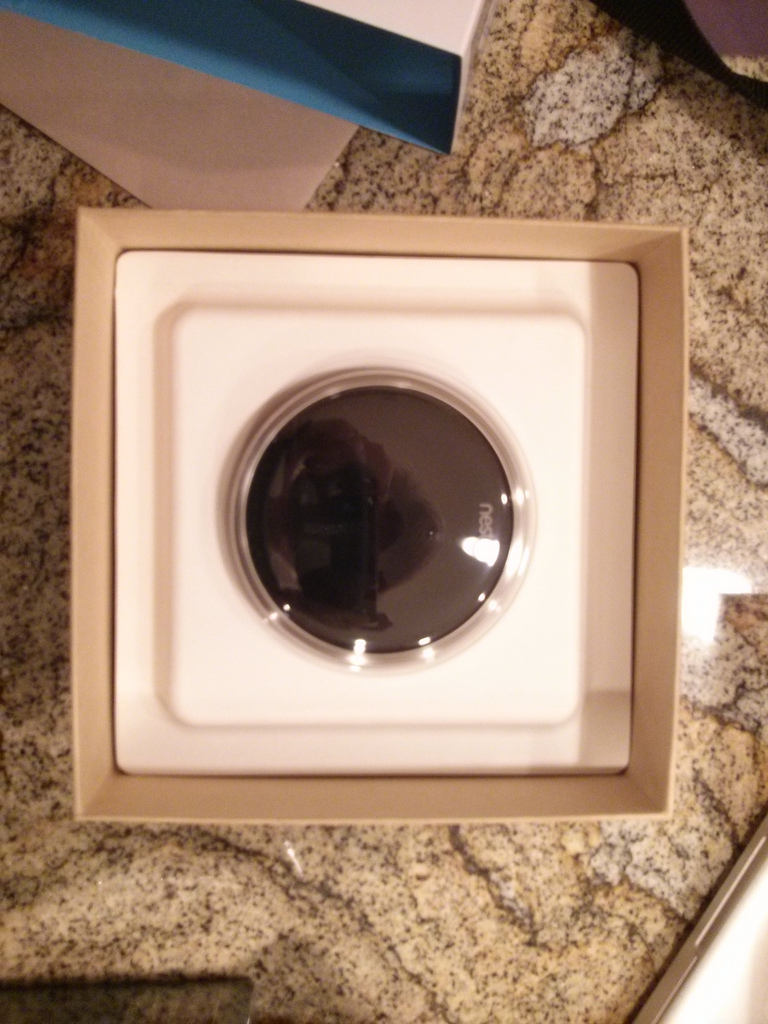Let's run over the setup in the house so far, on a basic "what's plugged in and actually working and connected" level.
Nest Thermostat
The Nest thermostat was the first bit I picked up. It wasn't available to me until I moved Stateside and the slick-looking design had me. It arrived on a week Husband was away and I was dubious about setting it up myself, having never opened up the wiring for a thermostat before, but it turned out to be a piece of cake.
Unboxing the nest
The Nest works decently. Living in San Francisco in a relatively new apartment, we don't have a lot of issues with heating (we don't have central air for cooling, either) , so it mostly just gets to do nothing except report the temperature hovering at roughly the same value all the time. It had a bunch of issues staying on the WiFi but recent firmware updates seem to have cleared that up. So, it's cute, but I feel bad that we don't live somewhere more interesting for it to do its thing.
Nest (now owned by Google) also now owns DropCam, which we've got a couple of. We're only using the one in the garage right now, but it's very reliable.
SmartThings Hub
Basically, all these "smart home" setups require some sort of controlling hub device. There's a few on the market, and I ended up getting a SmartThings hub last year (so it's the first gen one). I went with this one because at the time it seemed to leave the most doors open to me - not only did it connect with its own devices, it also connected to Belkin, Philips, Sonos and a few others, plus it had IFTTT integration. I'm pretty sure most of the hubs on the market these days do similar door-propping-open exercises, but I haven't bothered to check. The main downside is it'll lock you into that hub's API and apps for the most part, and SmartThings is hardly the best app - it's slow and finicky to setup - but their API is handy and I'll explain why another day. A bunch of our lights and dimmers and such are controlled via SmartThings, notably:
- My desk electronics (except my laptop charger) are plugged into a power strip connected to a smart switch. A movement sensor triggers that switch on and off depending on whether I'm at my desk or not, so the lights are only on when I'm actually using them.
- I have a remote in the bedroom that lets me control the lights - I can toggle on and off the bedside lights (both connected to their own switches) and the ceiling lights. I can also use the remote to trigger the "Good Morning" action in Smarthings, which brings on the lights and has the Bedroom Sonos play the days weather forecast.
- We've replaced the dimmers in the bedroom, living room, dining area and kitchen with the smart dimmers - so they're all controllable from the app. They are all configured to turn off when we leave the house (both of us - our presence is set by our phones location within the house geofence), and have automatic lighting sequences configured for vacation time.
- The kitchen has a motion sensor to detect activity in there, and toggles the dimmers on and off appropriately.
- Likewise, the living room lights come on at dusk and toggle on and off based on our activity via a motion sensor.
- All the downstairs lights turn off when activity ceases, and all the lights in the house turn off when I trigger the "Good night" action on Smartthings.
- The hall light turns on when the front door opens (this is one of my favourite interactions - subtle, but very effective).
- We have open/close sensors on the office window (so I know when Husband has forgotten to close it when we go out - it's the only easily people-accessible window) and the external doors.
So, that's the basics. Back soon to cover some of the more custom parts.

